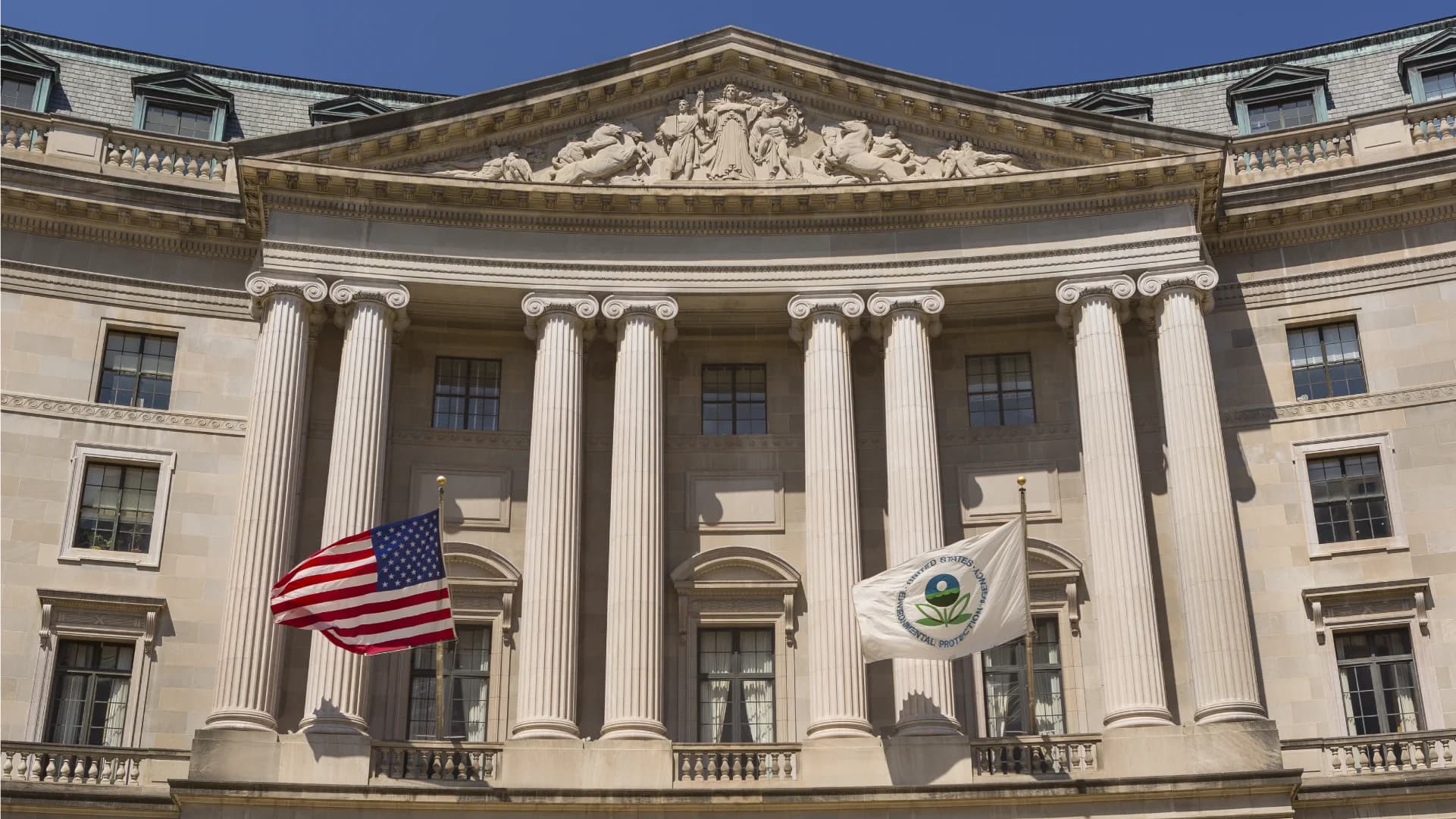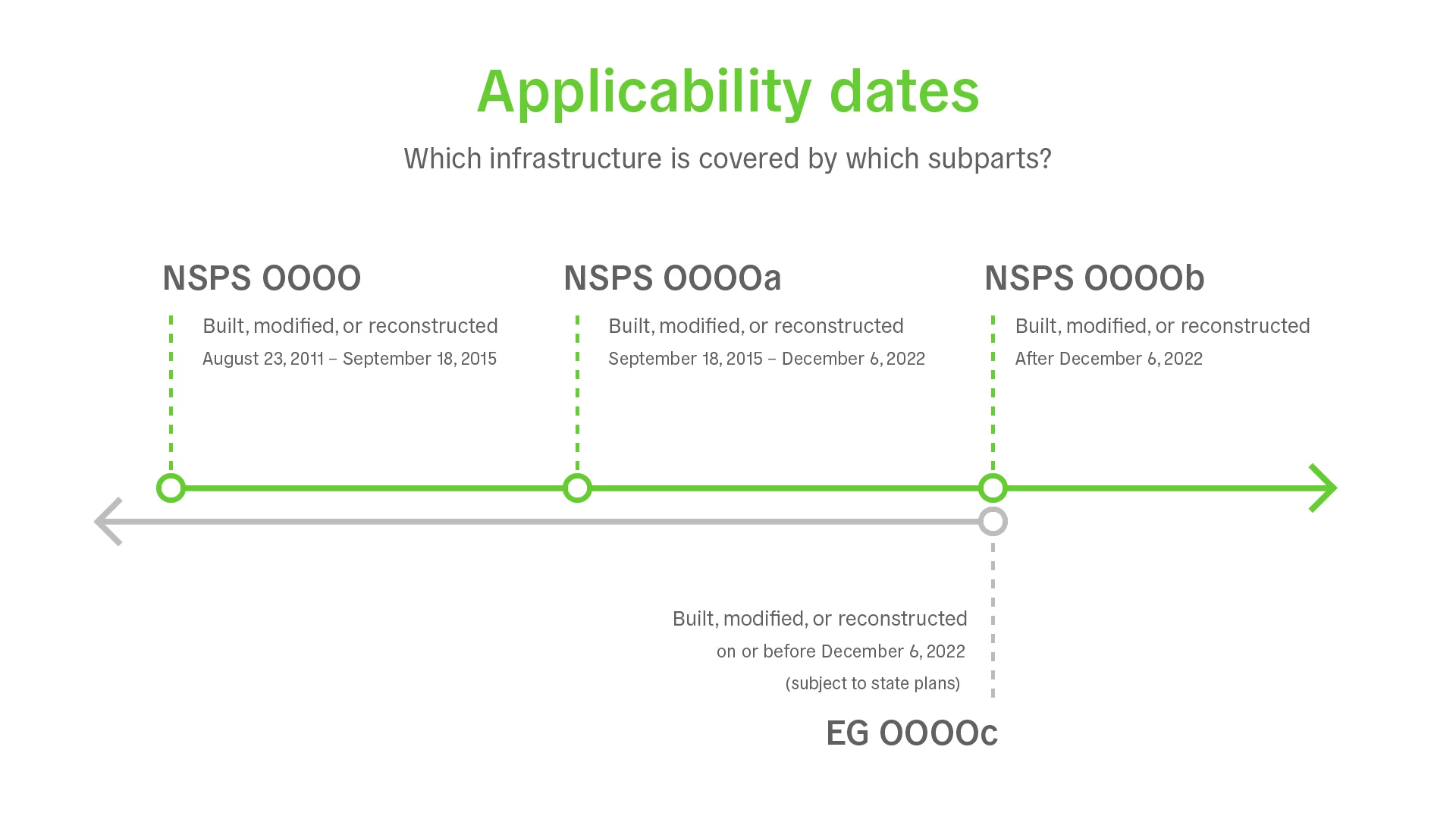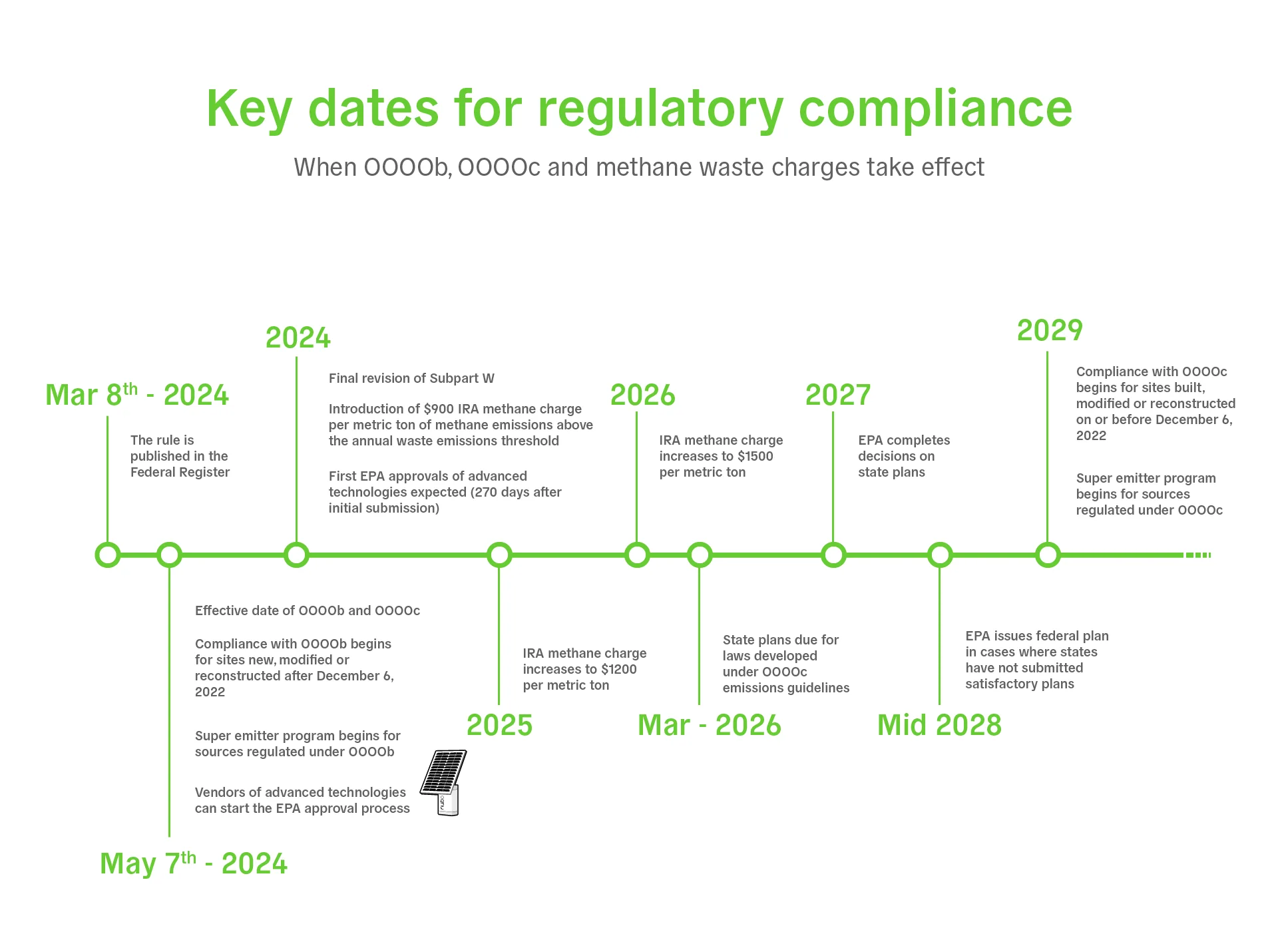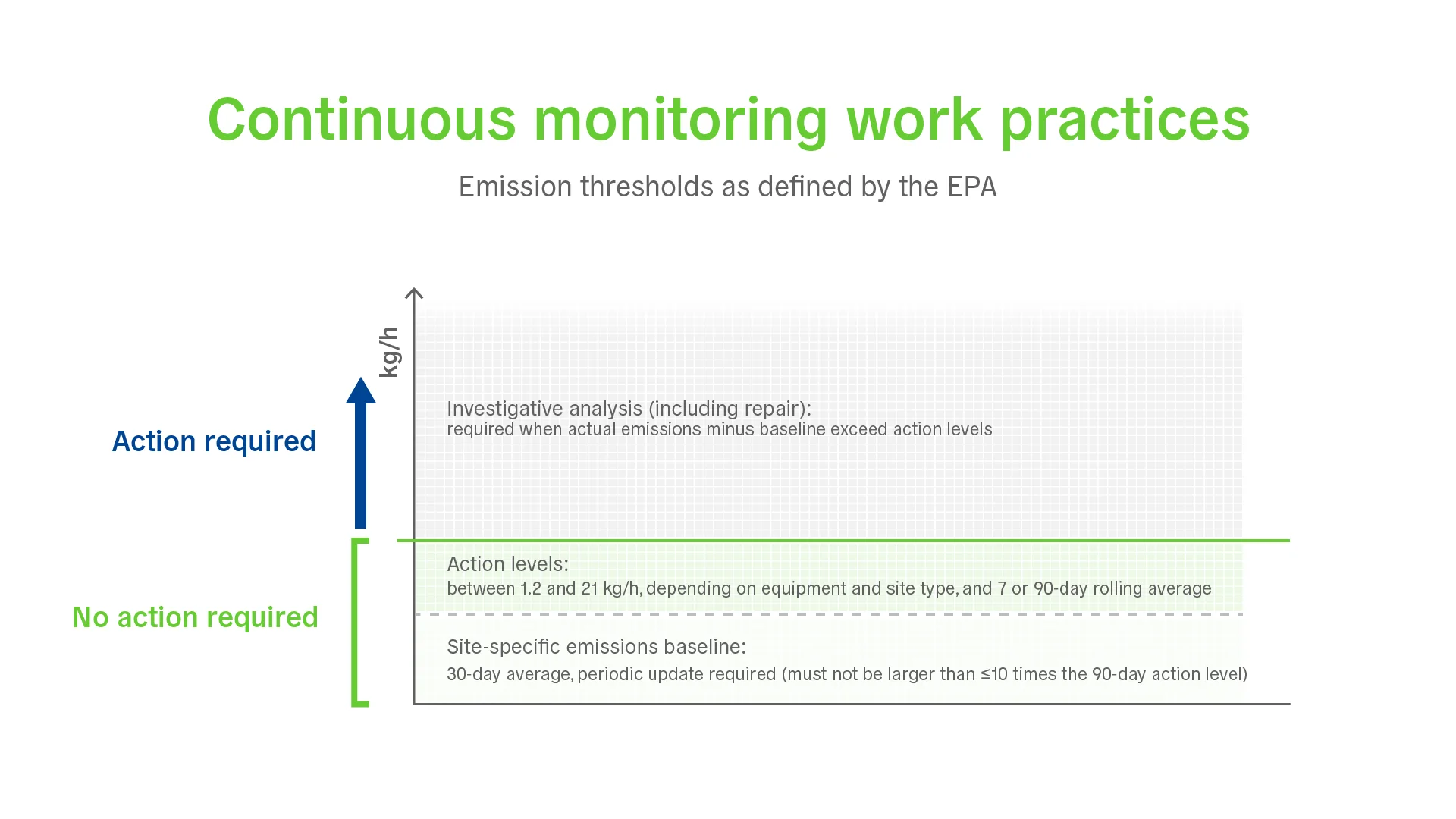24.01.2024
Unpacking the EPA's new regulations on methane emissions: how continuous monitoring supports compliance and qualifies super emitter emissions events
The EPA's revised New Source Performance Standards for methane emissions from oil and gas operations come into effect as soon as March 2024. Learn what you need to know to ensure compliance and continued success—especially when using a continuous monitoring solution such as Nubo Sphere.
- Industry Insights
- Oil & Gas

Table of contents
Executive summary
In December 2023, the US Environmental Protection Agency (EPA) announced a new rule that will reduce methane emissions from oil and gas operations, which are, according to the EPA’s fact sheet, “the largest industrial source of methane pollution in the U.S.” With this rule now final and its effective date approaching, the time is now for oil and gas operators to not only ensure their compliance with the rule, but also to take advantage of the new opportunities it presents.
We have prepared this article to unpack the rule’s requirements and opportunities*.
The EPA has designed the rule to be flexible. Operators will have time to bring existing equipment into compliance. In the meantime, operators of both new and existing methane emissions sources will be able to leverage the latest technologies in methane emissions monitoring to not only detect and reduce fugitive methane emissions at well sites, centralized production facilities and compressor stations, but to streamline monitoring processes.
Nubo Sphere, as a leading continuous monitoring solution, will be here to support oil and gas operators on the road to success through this emerging regulatory landscape. Especially while Canada and the European Union are simultaneously finalizing similar regulations promoting the use of advanced technologies.
This article provides guidance to the rule's terms and subparts relevant to oil and gas operators. It also includes a timeline for compliance—for operators of new and existing infrastructure alike. These first two sections are the groundwork for our analysis of how these regulatory changes will affect oil and gas operators.
Throughout the rule, it's clear that the EPA intends to incentivize the use of advanced technologies both in the short and middle term. To that end, they have developed work processes for, among other things, continuous monitoring. We have included a section analyzing how this, specifically, will look for operators.
Finally, this article includes a look at the new Super Emitter Program. This program introduces third-party monitoring for large emissions events. Acting in concert with methane charges introduced under the Inflation Reduction Act and new standards for GHG reporting, it will be a powerful deterrent to super emitter emissions events. Once again, continuous monitoring stands to help operators.
For reference, the prepublication version of the rule is available here. We have included reference page numbers for your convenience.
If you would like to download the article as a printable PDF, please click here: Download
Definitions: what are OOOOb, OOOOc and the rest?
This article refers to a selection of subparts of the Code of Federal Regulations. We have included definitions of these subparts below.
OOOO, OOOOa, OOOOb are all subparts of a US federal regulation, Title 40 CFR Part 60, otherwise known as the New Source Performance Standards (NSPS). OOOOc is another subpart within Title 40 CFR Part 60 that provides Emission Guidelines for states to use in developing regulatory actions for existing sources.
Together, these subparts regulate new and existing sources of methane emissions. These regulations apply to different sites based on the date of construction, reconstruction, or modification of the equipment on site. In short, OOOOb is the new regulation for new equipment. OOOOc will, in the future, regulate existing equipment currently regulated by OOOO and OOOOa and equipment that has never been regulated.
The definitions:
OOOO and OOOOa are currently applicable NSPS. Together, they regulate infrastructure built, modified, or reconstructed between August 23, 2011, and December 6, 2022. A built, modified, or reconstructed date of September 18, 2015, marks the change in coverage from OOOO to OOOOa.
OOOOa now includes an amendment allowing operators to use advanced methane detection technology, such as continuous monitoring, and work practices as approved in subsection OOOOb. This amendment is intended to bridge the 5-year gap between OOOOb and OOOOc being finalized, such that from 2024 to 2029, operators of OOOOa sites may already use OOOOb standards for compliance.
OOOOb regulates new infrastructure with a revision to NSPS for infrastructure built after December 6, 2022. It includes enhanced requirements for operations and emissions monitoring and requires reductions in flaring and venting.
Notably, the new standards for emissions monitoring now allow the use of continuous emissions monitoring solutions such as Nubo Sphere or other advanced technologies.
The EPA expects these regulations to reduce methane emissions from new onshore oil and gas affected facilities, such as wells, compressors, process controllers, storage vessels, sweetening units, pumps, and processing and production equipment. They also expect emissions reductions from facilities regulated under OOOOa that use the advanced methane detection technology and practices approved in OOOOb.
OOOOc is a new subpart of emissions guidelines for states to use in developing and implementing their own performance standards to limit emissions from sources built, modified, or reconstructed on or before December 6, 2022. Once states have implemented these laws, OOOOc will replace OOOO and OOOOa. Final operator compliance deadlines are still 3 – 5 years away. In the next section, we provide a summary of compliance deadlines.

Subparts OOOO, OOOOa, OOOOb and OOOOc will all, at different times, regulate emission events covered under the new Super Emitter Program (SEP). We will examine the SEP in detail below.
This article also refers to Subpart W of 60 CFR Part 98 (Mandatory Reporting of Greenhouse Gasses) which regulates reporting of greenhouse gas (GHG) emissions. The EPA is presently amending Subpart W, a process they will complete mid-2024, to require operators to report large emissions. New methane waste emissions charges mandated in the Inflation Reduction Act (IRA) will be based on these reports and go into effect for the 2024 reporting year (filed in March of 2025).
When do you need to comply with OOOOb or OOOOc?
The EPA expects compliance with these new regulations at different times, with OOOOb compliance expected in March 2024, and OOOOc projected to come into effect at the latest in 2029.
Most operators regulated under OOOOb have 60 days after the rule enters the Federal Register to comply. The unofficial version of these regulations was published on December 2, 2023—as of January 2024 they are queued for publication at the Federal Register. This puts the rule’s effective date sometime in March 2024.
Operators of equipment built, modified, or reconstructed before December 6, 2022, will have more time until subsection OOOOc applies (see pages 737 – 757 of the prepublication version of the rule).
Remember: OOOOc contains emissions guidelines for the development of state-level performance standards. From the rule’s effective date, therefore, states will have 24 months to submit plans developed under the emissions guidelines of OOOOc. The EPA will have 60 days to determine if a state plan is complete and, if it is, a further 12 months to act on it. If the EPA determines that state laws aren't complete, the EPA will have 12 months to promulgate federal law. Either way, this leaves operators with at most 36 months to comply with these regulations.
This puts the compliance date for regulations developed under the guidance of OOOOc somewhere in Q1 2029—five years from the effective date of the rule.

What does this mean for oil and gas operators?
These regulations have significant implications for oil and gas operators—and for vendors of continuous monitoring solutions.
With OOOOb and OOOOc, the EPA is updating its best system of emissions reduction (BSER) analysis. Broadly, this update calls for more frequent monitoring. But it also introduces an EPA approval process for advanced technologies such as continuous monitoring solutions. Critically, continuous monitoring stands to ease the burden of frequent monitoring. It also eliminates optical gas imaging (OGI) follow-up obligations.
Here are the key points in detail:
- All sites, including shut-in wells, require monitoring. Almost all sites require more frequent monitoring. As frequent as quarterly monitoring with optical gas imaging or Method 21 work practices to support leak detection and repair (LDAR) works, is required on most upstream and midstream sites. However, advanced methane detection technologies, approved by the EPA based on detection thresholds and other specifications, can reduce frequency and other periodic monitoring obligations.
- Approved continuous monitoring solutions may now replace any OGI or Method 21 inspections! This stands to reduce operator costs, effort and travel time to remote sites while also improving safety.
- The Super Emitter Program introduces new rules for monitoring, investigating, and reporting large emission events. This will introduce a new process for using third-party remote surveys, and work in concert with methane waste charges and GHG reporting introduced separately.
Work practices for using continuous monitoring
The EPA provides work practices for using continuous monitoring under subpart OOOOb. Below, we have summarized the work practices as described in section §60.5398b(c) starting on page 994 in the EPA's prepublication version of the rule.
Please don’t hesitate to reach out if you have any questions about the EPA’s work practices or would like assistance in any part of this process. We're here to help.
Requirements for EPA approved continuous monitoring solutions:
- Detect methane with a minimum detection threshold of ≤ 0.4 kg/h (determined as 1/3 of the lowest action level specified below to achieve the necessary resolution)
- Determine and record a valid methane mass emissions rate or equivalent (methane concentration readings in ppm only) at least once every 12-hour block. Note: It will remain to be seen how a sensor that provides concentration readings only will demonstrate during EPA’s methods approval process the ability to determine site-wide emission rate based action levels quantitatively.
- Maintain a rolling 12-month average operational downtime of ≤ 10% (based on power and function of the devices being checked at least twice every six-hour block)
- Transmit all applicable data at least once every 24 hours. A common understanding with EPA is yet to be reached which data this includes.
Sensirion’s Nubo Sphere solution does meet all of those requirements and is ready to support your monitoring program 24/7, all year round. The EPA's approval requirements for continuous monitoring solutions are available on pages 995 and 996 of the prepublication document. The EPA has also provided work practices for continuous monitoring. In short, it has revised its action levels to account for site specific baseline emissions and to enable timely LDAR. We take a deeper look at work practices in the following section.
EPA action levels on methane emissions
The EPA specifies the following action levels based on type of site and 7-day or 90-day rolling average calculations. Those action levels are meant to achieve two things:
- Exceeding the 7-day action level alerts operators of large, short-term peaks in emissions above the expected baseline during normal operation.
- Exceeding the 90-day action level reveals slower, longer-term increases of undetected, likely small emissions events.

How do I deploy a continuous emissions monitoring solution in compliance with the EPA’s NSPS OOOOb regulations?
- Submit monitoring plans to the EPA. These must include the number and locations of monitors, calibration requirements, and identification of critical monitoring system components. Plans must also include procedures for managing system downtime, establishing baseline emissions, determining when fugitive emissions have been detected, identifying and repairing emitting infrastructure, and record keeping.
- Install an EPA approved continuous monitoring system on site within 120 days of startup of new or modified infrastructure, and no later than the date by which the next BSER monitoring survey would have been required.
- Determine site-specific baseline emissions. Begin by eliminating all fugitive emissions — “clean” the site as well as possible. Then, calculate the mean emission rate in kg/h of methane for a 30-day operating period. Operations during this period should limit maintenance activities (or exclude emissions from those activities from the baseline calculation) but must account for varied operations and represent annual production or throughput. Finally, the determined baseline should not exceed 10-times the EPA’s defined 90-day average action levels (1.2 kg/h for wellhead only sites or 1.6 kg/h for other well sites and compressor stations)—i.e depending on the type of site, this will be 12 kg/h (wellhead only site) or 16 kg/h (other well sites and compressor stations).
- After baseline determination, once the monitoring system has been running for seven days, calculate a seven-day rolling average mass emission rate in kg/h of methane. Recalculate, subtracting the site-specific baseline, daily. After 90 days, repeat to calculate a 90-day rolling average.
- If emissions exceed the EPA's pre-defined action levels, begin an investigative analysis into the causes of ongoing emissions within five days. Complete this investigation and initiate action to bring emission rates back below the allowed action level within five days in case of an exceedance of the 7-day action levels, or within 30 days if 90-day action levels are surpassed.
- If, after initiating action, average emission rates remain above action levels 24 hours (7-day action level) or 30 days (90-day action level) after completion of the investigative analysis, develop and submit a “mass emissions rate reduction plan” within 60 days of exceeding the action level. Note that additional time is allowed if the actions needed to reduce the emission rate below the applicable action-level will take more than 30 days to implement.
- Maintain records and submit reports to the EPA or state regulatory offices.


Sensirion’s Nubo Sphere solution will take care of the calculation of those rolling averages through the Nubo Sphere platform, as well as providing assistance in alerting and root cause analysis in case of fugitive emissions leading to an exceedance of the EPA’s action levels.
The EPA leaves operators free to investigate and remedy emissions that exceed action levels as they see fit. By forgoing the follow-up requirements prescribed for other periodic monitoring options, the EPA has streamlined monitoring work practices and incentivized operators to use continuous monitoring. Ultimately, results matter more than specific practices.
As defined in the above work practices, operators achieve results when actual emissions, minus initially determined baseline emissions, remain below EPA-defined action levels or are returned below action levels in a reasonable timeframe, and emissions are recorded and reported.
The Super Emitter Program
The EPA is now introducing the Super Emitter Program (SEP). The SEP allows EPA certified third parties to monitor and report super emitter emission events to the EPA. The EPA will, in turn, evaluate these reports for completeness and notify operators. The SEP includes requirements for operator follow up on reports, and the EPA will make all super emitter data available to the public on the Super Emitter Program Portal.
According to the EPA, a super emitter emissions event is any methane emission exceeding 100 kg/h located at an individual well site, centralized production facility, natural gas processing plant or compressor station.
Certified third parties will use approved remote methane detection technology to detect super emitter emissions events. This technology will include satellite, aircraft, or remote monitoring platforms approved through the alternative test method approval process, but OGI and continuous monitoring systems used in facilities are not suitable for third-party monitoring. Finally, third parties will not be allowed within facilities.
Operators are required to investigate all SEP notifications. Operators will have 15 days to determine the cause of the event and may use approved continuous monitoring solutions to support their investigations—especially to determine the actual start and end of super emitter emissions events to inform reporting.
Beyond this rule, the Inflation Reduction Act (IRA) has introduced relevant changes to charges on methane waste and the Greenhouse Gas Reporting Program (Subpart W). The Methane Waste Emission Charge rule will charge operators for emissions, as reported under Subpart W, that exceed waste emissions thresholds. In concert with regulations OOOOb and OOOOc, these will incentivize monitoring and reduction in methane emissions.
Operator response to super emitter emissions events
Upon detecting a super emitter emissions event, third parties are required to notify the EPA through the Super Emitter Program Portal within 15 days. The EPA will evaluate all provided third-party data, publish the location of super emitter emissions events online using GPS data, and notify operators of super emitter equipment.
Note that when third parties submit notification after the 15-day window, the EPA will take no further action against the operator. The EPA wants timely action; slow notification does not suit that end.
Upon notification of a super emitter emissions event, the operator has five days to initiate an investigation, using OGI, Method 21 or other approved technology, and 15 days to submit an initial report on the results of that investigation on the SEP portal. This must include the source and duration of the event. If the event is still ongoing at the time of the report, the operator must provide a plan to end the event. In that case the operator must later update the initial report with the exact end date of the super emitter emissions event.

How to stay ahead of the Super Emitter Program and IRA methane charges with Subpart W reporting rules?
The Super Emitter Program strengthens the case for using continuous monitoring. Consider an operator using periodic screening in compliance with OOOOb. Fugitive emissions on a site could exceed the super emitter threshold for weeks without their knowledge. The SEP accounts for this. Upon receiving third-party notification of the leak, the EPA would quantify the emission by multiplying the third-party's measured release rate by either 182 days or the time between the operator's most recent emission-free survey and their confirmation that they’ve complete repairs—whichever is shorter. These emissions would count towards the Methane Waste Emissions Charge.
Daniel Zimmerle, director of Colorado State University's Methane Emissions Program, explains how infrequent monitoring can miss massive fugitive emissions:
"The recent Subpart W proposal includes both a 250 mt CO2e total and 100 kg/h instantaneous threshold for reporting large emission events. And … if you're like me … when you see two numbers, you feel compelled to picture how they are related. The plot below shows what would need to be reported (colored areas), and how long it takes for an emitter less than 100 kg/h to trigger the 250 mt CO2e reporting requirement. I've marked these for a few typical aerial sensitivities (vertical lines) and for a few common inspection intervals. Bottom line: If you don't look often, you may often exceed the reporting threshold."

Source: LinkedIn | Daniel Zimmerle
That reveals the key to avoiding runaway super emitter emissions events: using continuous monitoring and self-reporting according to the amended Subpart W.
A quick response to super emitter emissions events would end the emission sooner, saving the operator thousands in emissions charges. Moreover, operators can also use continuous monitoring systems in investigative analyses to provide more precise data on emission quantity and duration than the EPA would otherwise have available, and even demonstrate when large emissions events are part of normal operations such as maintenance activities.
Conclusion
With this regulatory revision, the advantages of using continuous methane emissions monitoring have multiplied.
Quickly and accurately detecting, locating, and quantifying methane emissions presents a clear advantage for oil and gas operators: preserving saleable material, streamlining LDAR processes and meeting ESG goals, on top of detecting super emitters in a timely manner to avoid unnecessary fines.
In creating a strong, yet flexible, regulation the EPA has put oil and gas operators in a position to meet the rule's obligations with a lower process obligation. Continuous monitoring will feature in the success of both this regulation and all oil and gas operations.
To learn more about the Nubo Sphere continuous monitoring solution and how Sensirion Connected Solutions can help with regulatory compliance, get in touch with us!
*This is not legal advice. Please consult qualified legal counsel.
Related Insights Blog
09.05.2025
Proactive compliance with California’s Senate Bill 1137
The California Senate Bill 1137 (SB 1137) applies to oil and gas operations located in defined health protection zones within the state. Read on to learn how this bill will affect operations, and how Nubo Sphere can help achieve ompliance—not only with respect to SB 1137 but also California’s developing methane regulations in line with the US EPA’s EG OOOOc.
19.11.2024
How to use continuous monitoring for periodic screening: why Nubo Sphere is seeking EPA approval as a periodic screening solution
This article explores the advantages of continuous monitoring when used for periodic screenings. It includes guidance on the latest EPA regulations found in NSPS OOOOb and GHGRP Subpart W with an eye to efficiently reducing emissions through periodic screenings. Operators interested in upcoming regulations of sources built, modified, or reconstructed before December 6, 2022, can expect similar standards to those found in NSPS OOOOb, but only after state laws have been created in line with the EP
19.11.2024
Continuous monitoring in light of the EPA’s OOOOb and Subpart W
Continuous methane emissions monitoring with Nubo Sphere equips oil and gas operators with year-round oversight of oil and gas assets, quick detection of fugitive methane emissions and actionable insights in support of LDAR activities. The EPA has introduced standards for using continuous monitoring aimed at reducing emissions without unduly increasing operators’ workloads. This article provides in-depth guidance to working with these regulations, focusing on work practices for continuous monito
